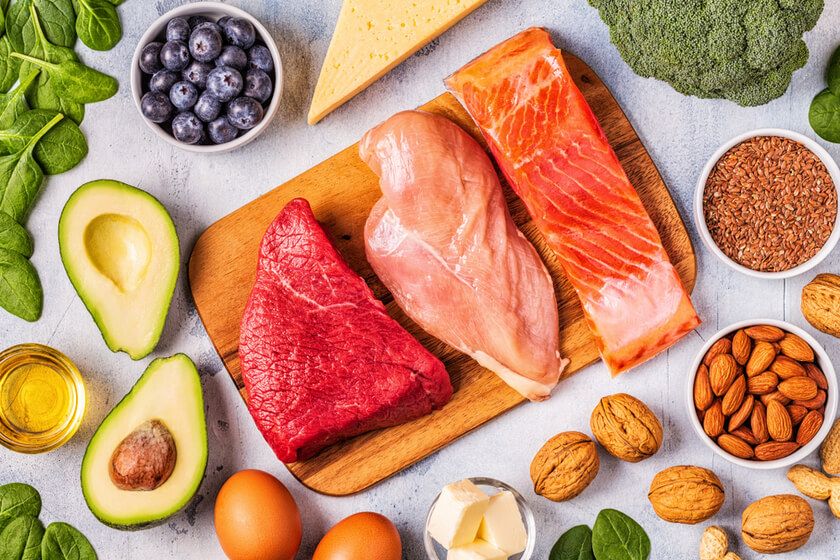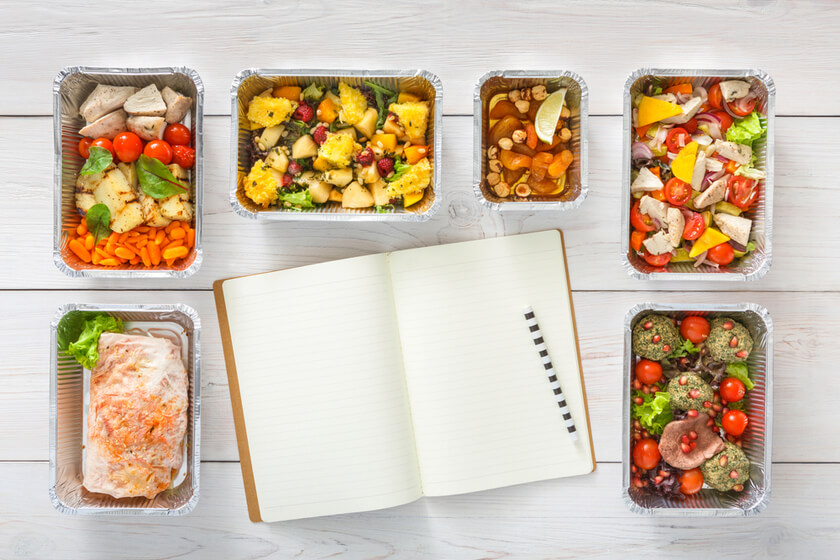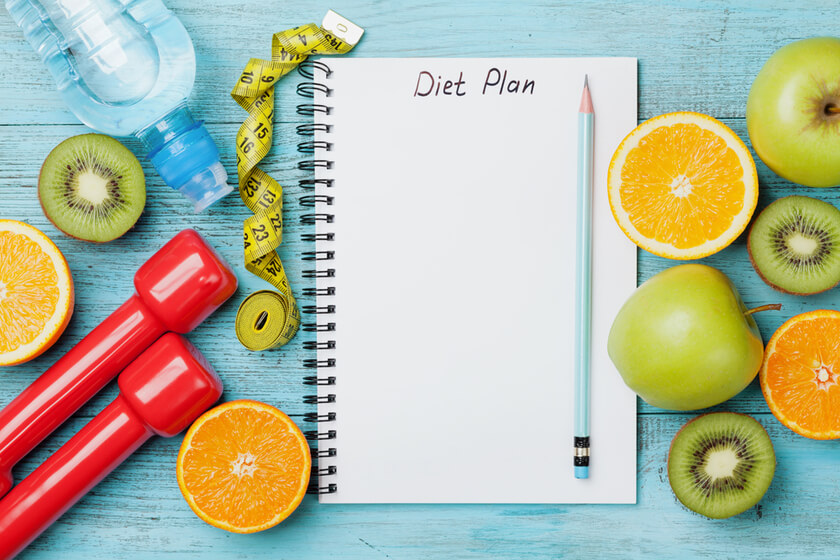2 Weeks On a Low-Carb Diet: A Complete Guide

Carbohydrate reduction is famously considered a fast-track way to shedding excess pounds.
So, it comes as no surprise that low-carb diets are practiced by many to lose weight.
Switching up your diet is one of the best solutions to reach your desired weight, and at the same time, improve your mental well-being. It’s a win-win once you start eating healthy foods and monitoring your carb count.
But where do you start, and which diet do you follow?
There are various low-carb meal plans in the diet world, from the Atkins diet to the ketogenic diet. You can research several methods to find the one that suits you.
Overall, the premise of cutting your carb intake is to curb appetite, eat fewer calories, lose fat, and achieve healthy weight loss.
This article talks you through everything you need to know to follow a low-carb diet in two weeks and whether it’s possible to lose weight in such a short time.
Low-Carb Diet Weight Loss in 2 Weeks: Mission Possible?
Mission possible or impossible?
How much weight you can lose in just two weeks is an individual process.
People lose weight at different rates, as variables like age, body type, and metabolic rate all take a role.
Although there is no guarantee of your outcome, achieving weight loss in a short period is possible.
The power lies in creating a calorie deficit, which means burning more calories than you consume. You ultimately need to eat less and burn more to achieve a calorie deficit. A combination of exercise and cutting calories is enough to do the trick.

Advertisement
A ketogenic diet app designed to make keto easy. From the start.
- Personalized meal plans & workouts
- 10,000 keto recipes + vegetarian-friendly recipe database
- Customizable grocery list
- Calorie tracker
- Keto education and overviews of current trends
When using a weight loss diet for only a short time, it’s easy to make decisions that don’t benefit your weight loss goals in the long term. Instead of following fads, it’s better to approach your diet sensibly.
A temporary meal plan is tricky, as it’s possible to gain weight when you return to your everyday routines. Try smart solutions that are scientifically proven to help you lose fat that you can stick to even after the two weeks are up.
What’s a Low-Carb Diet, and How to Start?
A low-carb diet refers to a diet low in carbohydrates.
Carbohydrates are a macronutrient like fats and proteins. The body breaks carbs down into glucose. The glucose is absorbed into the bloodstream to provide your body with the energy it needs to work.
Carbs are found in healthy and unhealthy foods and are split into starches, fibers, and sugars.
A low-carb diet is an eating plan that targets weight loss. It demands that you monitor your carb count by restricting the number of carbs you eat.

Most low-carb diets suggest that you eat a higher proportion of protein and fats to make up your daily calories.
The removal of carbs can shock the system, as most people regularly consume carbohydrate-rich foods. But once you look at your carb intake, you can successfully cut back and enjoy other food groups.
Different diets recommend different carb counts. Some even use alternative calculation methods, like counting total carbs or solely focusing on net carbs. How many carbs you should eat depends on your personal health and goals.
To give you an insight into the restriction involved, let’s look at an average diet.
The general recommendation for the average American is to get 45–65% of daily calories from carbohydrates.
A low-carb diet generally consists of under 100-150 grams of carbs per day, less than 26%. With a meal plan like the ketogenic diet, carbs make up only 5-10% of your daily intake.
The reduction seems rather extreme, but it works for many to lose weight.
To get started with cutting and counting carbs, organization is key. Try the following steps to begin your two-week challenge.
#1 Educate yourself
If you’ve never given much thought to carb counting, you might be surprised at how many foods contain high levels of carbs.
Before heading to the grocery store, familiarize yourself with food categories. A little research into carbohydrates will give you the vital information to determine the carbs to avoid, limit, and make the most of during the two weeks.
#2 Plan meals
Start by planning your meals for the week. Planning ensures you don’t run out of ideas, mix up your carb count, or opt for last-minute cheat meals.
Don’t put yourself off with complicated recipes. Keep it simple.

#3 Remove temptations
When you cut your carb intake, it’s natural for your body to crave them.
A good idea to avoid a carb relapse is to remove carb-heavy foods from your home, especially simple carbs usually loaded with sugar.
What Happens When You Cut Out Carbs for 2 Weeks?
When you cut out a severe number of carbs from your diet, your body may go into nutritional ketosis.
Usually, the body sources fuel from the glucose provided with regular carb consumption. Without it, the body finds energy in another way.
Ketosis is a metabolic state in which the body creates ketone bodies from burning fat for fuel. It is the primary goal of the ketogenic diet, as burning fat equates to weight loss.
You can expect to reach ketosis on the keto diet within the first few days.
With a less-restrictive diet, fewer carbs may suppress your appetite, increase metabolism, and lead to gradual weight loss.
It can be difficult to tell at first if you have lost significant weight in a shorter period. Most weight loss at the beginning of any diet is water weight, not the result of fat burning.
You lose water weight as restricting carbs causes the depletion of your glycogen stores – the glucose storage found in your liver and muscles that helps retain water.
So, weight loss is achievable after two weeks of carb restriction, but how much weight you lose is entirely dependent on you individually.
How Much Weight Can I Lose in 2 Weeks on a Low-Carb Diet?
Losing one to two pounds of body weight per week is considered healthy weight loss.
Losing up to four pounds is a sensible goal with that in mind.
However, a low-carb diet can be effective in losing weight more quickly.
The Atkins diet claims that some can drop 15 pounds in the first two weeks. However, those results are not the average results to expect.
How much exactly you can lose depends on your overall calorie intake. As well as counting carbs, you need to watch out for calories in the other foods you eat.

You might think it’s safe to fill up on junk food, but the nutritional value of food is significant for losing fat.
Incorporating healthy foods like leafy greens, non-starchy vegetables, and lean proteins will promote weight loss. And when upping your fat intake, opt for healthy fats like olive oil, avocados, nuts, and seeds.
Another influential factor of weight loss is physical activity level. A good combination of diet and exercise is your best option to lose weight quickly and effectively.
How to Eat Low-Carb
Low-carb diet weight loss requires a significant reduction in carbs.
It means avoiding unhealthy carbs and focusing your small intake on healthier products.
Many carb-heavy foods fall under the list of refined foods. Refined foods are heavily processed to remove almost all nutrients. They are often considered empty calories, providing no nutritional value to your body.
Examples of refined carbs include:
- Sugary breakfast cereal
- Pastries, donuts, and candy
- Refined grains including white bread, white flour, and white rice
- Regular pasta
- White potatoes
- Potato chips
- Sugary drinks
Instead of the above, focus on carbs considered “good.” Examples include:
- Whole grains like brown rice, multigrain bread, barley, and oatmeal
- Non-starchy vegetables including leafy greens, Brussels sprouts, artichokes, and tomatoes
- Legumes, i.e., beans, peas, and lentils

You can easily switch to healthier carbs when you learn the difference between those stripped of nutrients and those rich in goodness. You can benefit from the nutritional element without consuming high carbs.
As for the rest of your diet, include high-protein foods like eggs, fish and shellfish, lean meats, poultry, and seeds.
With the go-ahead to eat more fats, choose healthy fats over processed and fried foods.
Healthy fat foods include:
- Avocados and avocado oil
- Nuts and nut butter
- Seeds including chia, hemp, and flax
- Olive oil
- Cheese
- Butter
For extra support and guidance with the keto diet, the Keto Cycle app acts as a personal assistant. It is a beneficial addition for keto beginners or those who have tried and failed on the keto diet.
The app offers personalized meal plans and workouts, thousands of recipes, calorie tracking, and motivational tips to keep you engaged.
With Keto Cycle, the low-carb process becomes easier to navigate and manage.
Is a Low-Carb Diet Healthy?
A low-carb diet is as healthy as you make it.
It can be detrimental to health to cut out carbs completely. A sensible low-carb meal plan ensures you are still eating carbs, although fewer than normal.
To lose weight healthily, choose good sources of carbs for the limited amount that you do eat.
A diet is healthy as long as you get enough calories and nutrition from your food choices. Some research suggests that a low-carbohydrate diet can support the heart if you consume protein and fat from healthy sources.
An overall reduction in processed foods can benefit your overall health, reducing the risk of diabetes, heart disease, and other heart conditions.
A Word From RD
Weight loss through carb restrictions is a popular method.
Eating low-carb meals can help you shed pounds as the body turns to stored fat instead of glucose to burn through for energy.
Severe carb restrictions can cause side effects, particularly for those following the keto diet. As your body combats the rapid changes, you may experience dizziness, fatigue, and headaches.
To reduce negative symptoms, you should continue to consume nutritional sources of carbohydrates, although in smaller doses.
There are lots of healthy carbs to choose from over unhealthy ones.
As you up your fat and protein intake, be mindful of what you put into your body. A low-carb diet isn’t an excuse to eat rubbish. It’s a chance to take control of your bad habits and replace them with healthy lifestyle changes.
Before beginning a restrictive diet, consult a health expert to pin down a safe diet plan for you.
From the keto diet to Atkins, there are plenty of options to choose from to guide you through a 14-day plan of action.
Conclusion
If you’re trying to find a worthwhile diet to lose weight in two weeks, opting for a low-carb meal plan has the potential to speed up your weight loss.
Boost your weight loss progress with regular exercise and smart food choices to reap the benefits. People lose weight faster by improving overall eating habits. Your diet is the first place to start if you want to lose fat.
Remember, losing weight is more sustainable when you do it gradually, rather than cramming your efforts into one intense period.







Comments (0)